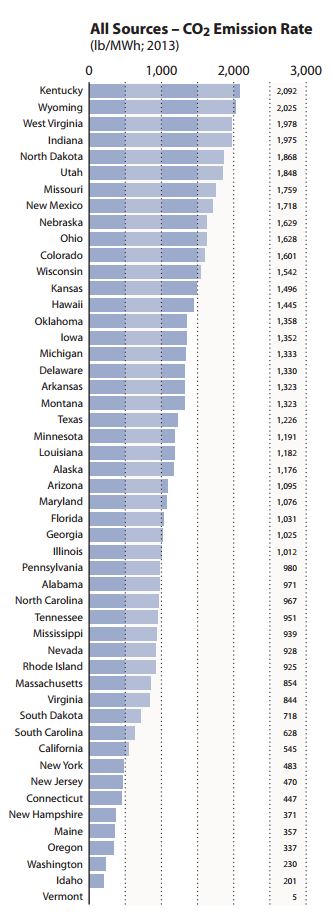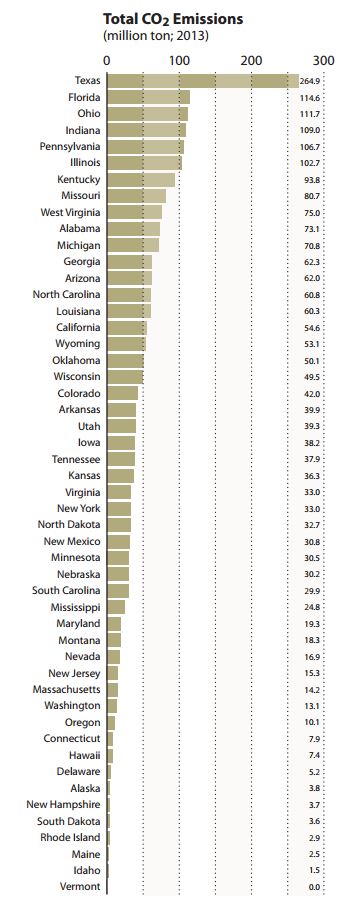by James A. Bacon
The Gooze, known in more polite company as Peter G. , is a big fan of solar power and wind power and thinks we ought to have more of both in Virginia. In his most recent post, he seems particularly impressed by the activities of Amazon Web Services, which has announced plans to build the largest solar facility east of the Mississippi in Accomack County and has joined in a large wind project in North Carolina. What Virginia needs to do, he suggests, is enact a mandatory Renewable Portfolio Standard (RPS) requiring Virginia electric utilities, like those in neighboring North Carolina and Maryland, to utilize more renewables such as solar, wind and biomass regardless of how much more expensive they may be than conventional power sources.
It’s helpful to remind ourselves exactly where Virginia stands nationally in the emission of Carbon dioxide (CO2), the gas that is both essential to life and implicated in global warming. The following data comes from “Benchmarking Air Emissions of the Largest 100 Electric Power Producers in the United States,” published by M.J. Bradley Associates, which bills itself as a strategic environmental consulting firm. No, the report was not funded by the Koch Brothers. It was prepared in consultation with Bank of America, several electric utilities and the Natural Resources Defense Council.
The report looks at two broad measures of carbon intensity: Total CO2 emissions for each state, and the CO2 emissions rate — emissions per megawatt hour of electricity generated. First total CO2 emissions:
Texas is by far the biggest CO2 emitter in the country. That reflects the fact that (1) Texas has a large gross domestic product (GDP) and (2) a fossil fuel-heavy electric generation mix. Note that although Virginia has the 11th largest state economy in the country, it ranks 26th by total CO2 emissions. In other words, Virginia is far more CO2-efficient than the national average.
(This measure is, admittedly, a rough one and overlooks important nuances. For example, Virginia has built one of the nation’s largest clusters of data centers, which consume a tremendous amount of electricity but replace electricity that would have been consumed in other states had businesses not outsourced their computing and data storage to the cloud. On the other hand, Virginia is a net importer of electricity from other states, meaning that some of the CO2 emissions attributed to its economy is allocated to other states.)
 Here are the numbers for the CO2 emissions rate, which reflects fuel mix. Virginia’s fuel mix includes a lot of zero-CO2 nuclear power as well as natural gas, which, though a fossil fuel, releases less CO2 per kilowatt hour than coal or oil. By this measure, Virginia ranks 38th on the list — lower than the two states with renewable portfolio standards that Peter admires so much, Maryland and North Carolina.
Here are the numbers for the CO2 emissions rate, which reflects fuel mix. Virginia’s fuel mix includes a lot of zero-CO2 nuclear power as well as natural gas, which, though a fossil fuel, releases less CO2 per kilowatt hour than coal or oil. By this measure, Virginia ranks 38th on the list — lower than the two states with renewable portfolio standards that Peter admires so much, Maryland and North Carolina.
Not only does Virginia emit less CO2 per megawatt hour than its two neighbors, its average electricity costs are lower. According to the U.S. Energy Information Administration (not funded by the Koch Brothers, by the way), here’s how electric rates compare based on 2013 data:
Virginia — 9.07 cents per kilowatt hour.
North Carolina — 9.15 cents per kilowatt hour.
Maryland — 11.3 cents per kilowatt hour.
And for purposes of comparison, California, the state that has gone “all in” with renewable energy — 13.5 cents per kilowatt hour.
My point is not that renewable energy is bad. Eventually, the cost of renewables will be competitive with other fuels, and then we should embrace them. My point is that there are trade-offs entailed with imposing renewable energy before it’s ready for prime time. One of those trade-offs is price. Once upon a time, progressives like Peter deemed it outrageous for power utilities to raise their rates on the grounds that a high cost of electricity punished the poor. No longer. Fear of global warming trumps social justice. The irony here is that Virginia’s electric power fleet outperforms North Carolina and Maryland in carbon intensity and price — all without mandated renewables. How about that?



